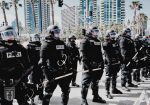Weapons of War On Our Streets – A Guide to the Militarization of America’s Police – Part 2
from Survival Blog:
 The Role of Civil Asset Forfeiture
The Role of Civil Asset Forfeiture
Civil asset forfeiture (CAF) is a major driver in the militarization of the police force. Put simply, CAF is a legal principle that allows police to seize money and property from “suspected” criminals, which they can do without a warrant because the suspect’s property doesn’t have the presumption of innocence. Note that police do not have to convict or even indict. Indeed, indictments are not even filed in over 80 percent of all cases. Police can simply seize property, more or less at will, with some property harder to seize than others. Seizure of anything under $20,000 will almost certainly stand because that’s about what it’s going to cost you to fight CAF in court.
Most of the money raised through civil asset forfeiture is filed under “other.” This can be anything from a $600 coffee maker to a tank. Because the burden of proof is so low and the benefits are so high, CAF is effectively a legally allowed form of theft by police officers, allowing them to purchase military-grade hardware with stolen property. Here is a short list of military hardware purchased with civil asset forfeiture funds:
- $5 million helicopter for the Los Angeles Police Department
- $1 million mobile command bus for Prince George County, Maryland
- $227,000 for a Lenco brand armored vehicle in Douglasville, GA, a town with a population of 32,000
- $54,000 for 27 M-4 assault rifles in Braselton, GA, a town with a population of 9,476
While not the sole, nor even the primary, means by which the police are becoming militarized, this is a significant method for police departments to bankroll their own militarization.
Highlights of Police Militarization
 It’s one thing to discuss police militarization simply in terms of weapons acquisition. It’s another to discuss police militarization in terms of actual incidents. Some high-profile incidents involving heavily militarized police are worth examining.
It’s one thing to discuss police militarization simply in terms of weapons acquisition. It’s another to discuss police militarization in terms of actual incidents. Some high-profile incidents involving heavily militarized police are worth examining.
- MOVE: In 1985, the Philadelphia police came into conflict with a militant black nationalist organization called MOVE over the clearing of a building. An armed standoff resulted in shots exchanged between the compound’s inhabitants and the police. Eventually, this erupted into a firefight involving both semi-automatic and automatic weapons. On the orders of the police commissioner, the building was bombed twice. The resulting fire spread to a total of 65 different houses in the neighborhood and caused 11 deaths, including five children under 13. Over 250 were left homeless due to the fires.
- Ruby Ridge: This is notorious within in the Second Amendment and liberty movements, so it hardly needs to be repeated. In 1992, the United States Marshal Service attempted to serve a bench warrant at Ruby Ridge, the home of Randy Weaver and his family. His wife Vicki and his 14-year-old son Sammy were shot by USMS and FBI agents armed with M16s, sniper rifles and weaponized vehicles. Randy Weaver’s attorney made accusations of criminal wrongdoing and a resulting 14-day Senate investigation called for sweeping law enforcement reforms to avoid another similar incident. Federal officers also killed the Weaver family dog.
- Branch Davidians: This is perhaps one of, if not the, archetypal example of a militarized police force greatly overreaching. Armed with .50 caliber rifles, M728 Combat Engineer Vehicles (which are effectively tanks) and M79 grenade launchers, the FBI and ATF engaged in a firefight with Branch Davidians inside. Controversy remains to this day with regard to who fired first and who started the fire that consumed the building, leaving 82 members of the church dead.
These are the big three, but there are many smaller events also worth mentioning. During the wreckage of Hurricane Katrina, private Blackwater contractors patrolled the streets with automatic weapons. They were accused of summary execution of looters. In a low point for militarized police in 2014, a SWAT team in Cornelia, Georgia severely mutilated the face of an 18-month-old baby boy with a flash bang grenade in a fruitless search for drugs.
The Role of SWAT Teams
 SWAT teams are effectively the military of the police force. Begun in 1965 in Philadelphia, SWAT teams were conceived as a way to restrain urban unrest, deal with hostage situations or handle barricaded marksmen like Charles Whitman.
SWAT teams are effectively the military of the police force. Begun in 1965 in Philadelphia, SWAT teams were conceived as a way to restrain urban unrest, deal with hostage situations or handle barricaded marksmen like Charles Whitman.
Indeed, early uses of SWAT seemed to be well within the range of appropriateness. In December 1969, the LAPD’s SWAT team squared off with the Black Panthers, with Daryl Gates requesting and receiving permission to use a grenade launcher. In May 1974, the same SWAT team had a several-hours-long gun battle with the Symbionese Liberation Army.
However, SWAT teams gradually began to tackle missions that were not, strictly speaking, appropriate for the tools in their toolbox. What’s more, once LAPD’s SWAT team became famous, every city seemed to want one. The number of SWAT teams in cities of 50,000 or more doubled between the mid-80s and late-90s, at which point 89 percent of all cities of this size had a SWAT team.
Some startling facts when it comes to SWAT teams:
- 62% of all SWAT deployments were for drug raids
- 79% of these were done on private residences
- Only 7% of all raids were done for situations SWAT was invented for – namely barricades or hostage situations
Even smaller cities have SWAT teams now, which raises the question of why. Mission creep is the short answer, with SWAT teams now being used for operations far beyond the original scope of their work. Put simply, the SWAT team was not created to serve every search warrant that comes across the desk of a small-town police force.
SWAT teams ostensibly exist to respond to “high risk” scenarios. But there are seemingly no guidelines for what makes a situation high risk. Sometimes local SWAT teams use a threat matrix. However, these matrices are highly subjective and vulnerable to abuse. Partial responses are discouraged. Either the SWAT team is not deployed at all or there is a full-throttle response.
To use one example of why these matrices don’t work, let us consider the presence or absence of weapons. There is no way of knowing whether or not weapons will be present. So officers must subjectively guess whether or not they believe weapons will be present. Unfortunately, officers are pretty bad at this guessing game. According to an ACLU report, SWAT officers believed weapons were present in 35 percent of cases, but only actually found them in a scant 13 percent. In 36 percent of cases where SWAT was deployed to find drugs, no drugs were found.
Fusion Centers: Surveillance and Snooping
 As the military’s tools for surveillance become more powerful, this too will trickle down to the local police.
As the military’s tools for surveillance become more powerful, this too will trickle down to the local police.
In at least one case, it already has. Fusion Centers are hubs for local, state and federal police to share information. They’re effectively intelligence-gathering done by various police agencies who pool their resources. While this isn’t an uncommon practice, the Fusion Centers have virtually no oversight and are filled with zeal for the War on Terror. While its primary existence was to surveil in the fight against terrorism, Fusion Centers have quickly ballooned to gather intelligence on just about anything – and it’s not just the police. The military participates in Fusion Centers, as does the private sector, which means they’re a privacy nightmare.
The federal government has pushed Fusion Centers and largely bankrolled them. Hundreds of FBI agents work with Fusion Centers, with the federal government providing hundreds of millions of dollars in federal aid. In the case of the Maryland Coordination and Analysis Center, the federal government created a Fusion Center at the state level, only eventually turning control of an ostensibly state agency to the state. 30 percent of these “state” agencies are physically located in federal office space.
Private sector companies collect, store and analyze data for Fusion Centers. This would be dangerous on its own, but the lack of any oversight makes it particularly troublesome. Even if a private sector has the best of intentions, malicious third-party actors could access some of your most sensitive data if it’s been datamined by a Fusion Center. A company without the best intentions can do all kinds of “government-approved” snooping into your personal affairs.
Another nasty surveillance tool currently being deployed by the police is the Stingray phone tracker. This is effectively a phony cell phone tower that snoops on cell phone calls, which can extract significant information about you from your cell phone. Originally to be used only in terrorism investigations, the Electronic Frontier Foundation notes that the LAPD “has been using it for just about any investigation imaginable.” They can also be used to jam or otherwise interfere with your phone signal. Stingrays are highly mobile and can be mounted to just about any vehicle.
All of this is part of an overall drive for increased police surveillance starting at the Department of Justice and the Department of Homeland Security and trickling down. “Total Information Awareness” was one of the more Orwellian euphemisms of the early Bush and Department of Homeland Security years. It was quickly renamed Terrorism Information Awareness, then codenamed “Basketball.” Its goal is to know everything, or at least as much as it can. In 2012, the New York Times reported that this program was “quietly thriving” at the National Security Agency.
Loading...



